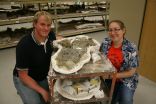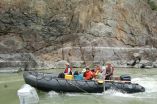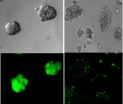(Press-News.org) Lausanne, Switzerland. EPFL scientists have discovered how to control the limbs of a completely paralyzed rat in real time to help it walk again. Their results are published today in Science Translational Medicine.
Building on earlier work in rats, this new breakthrough is part of a more general therapy that could one day be implemented in rehabilitation programs for people with spinal cord injury, currently being developed in a European project called NEUWalk. Clinical trials could start as early as next summer using the new Gait Platform now assembled at the CHUV (Lausanne University Hospital).
How it works
The human body needs electricity to function. The electrical output of the human brain, for instance, is about 30 watts. When the circuitry of the nervous system is damaged, the transmission of electrical signals is impaired, often leading to devastating neurological disorders like paralysis.
Electrical stimulation of the nervous system is known to help relieve these neurological disorders at many levels. Deep brain stimulation is used to treat tremors related to Parkinson's disease, for example. Electrical signals can be engineered to stimulate nerves to restore a sense of touch in the missing limb of amputees. And electrical stimulation of the spinal cord can restore movement control in spinal cord injury.
But can electrical signals be engineered to help a paraplegic walk naturally? The answer is yes, for rats at least.
"We have complete control of the rat's hind legs," says EPFL neuroscientist Grégoire Courtine. "The rat has no voluntary control of its limbs, but the severed spinal cord can be reactivated and stimulated to perform natural walking. We can control in real-time how the rat moves forward and how high it lifts its legs."
The scientists studied rats whose spinal cords were completely severed in the middle-back, so signals from the brain were unable to reach the lower spinal cord. That's where flexible electrodes were surgically implanted. Sending electric current through the electrodes stimulated the spinal cord.
They realized that there was a direct relationship between how high the rat lifted its limbs and the frequency of the electrical stimulation. Based on this and careful monitoring of the rat's walking patterns – its gait – the researchers specially designed the electrical stimulation to adapt the rat's stride in anticipation of upcoming obstacles, like barriers or stairs.
"Simple scientific discoveries about how the nervous system works can be exploited to develop more effective neuroprosthetic technologies," says co-author and neuroengineer Silvestro Micera. "We believe that this technology could one day significantly improve the quality of life of people confronted with neurological disorders."
Taking this idea a step further, Courtine and Micera together with colleagues from EPFL's Center for Neuroprosthetics are also exploring the possibility of decoding signals directly from the brain about leg movement and using this information to stimulate the spinal cord.
Towards clinical trials using the Gait Platform at the CHUV
The electrical stimulation reported in this study will be tested in patients with incomplete spinal cord injury in a clinical study that may start as early as next summer, using a new Gait Platform that brings together innovative monitoring and rehabilitation technology.
Designed by Courtine's team, the Gait Platform consists of custom-made equipment like a treadmill and an overground support system, as well as 14 infrared cameras that detect reflective markers on the patient's body and two video cameras, all of which generate extensive amounts of information about leg and body movement. This information can be fully synchronized for complete monitoring and fine-tuning of the equipment in order to achieve intelligent assistance and adaptive electrical spinal cord stimulation of the patient.
The Gait Platform is housed in a 100 square meter room provided by the CHUV. The hospital already has a rehabilitation center dedicated to translational research, notably for orthopedic and neurological pathologies.
"The Gait Platform is not a rehabilitation center," says Courtine. "It is a research laboratory where we will be able to study and develop new therapies using very specialized technology in close collaboration with medical experts here at the CHUV, like physiotherapists and doctors."
INFORMATION: END
From rats to humans: Project NEUWalk closer to clinical trials
2014-09-24
ELSE PRESS RELEASES FROM THIS DATE:
Immune activity shortly after surgery holds big clue to recovery rate, Stanford team finds
2014-09-24
The millions of people who undergo major surgery each year have no way of knowing how long it will take them to recover from the operation. Some will feel better within days. For others, it will take a month or more. Right now, doctors can't tell individual patients which category they'll fit into.
Now, researchers at the Stanford University School of Medicine have discovered that the activity level of a small set of immune cells during the first 24 hours after surgery provides strong clues to how quickly patients will bounce back from surgery-induced fatigue and pain, ...
Stanford scientists use stem cells to learn how common mutation in Asians affects heart health
2014-09-24
Over 500 million people worldwide carry a genetic mutation that disables a common metabolic protein called ALDH2. The mutation, which predominantly occurs in people of East Asian descent, leads to an increased risk of heart disease and poorer outcomes after a heart attack. It also causes facial flushing when carriers drink alcohol.
Now researchers at the Stanford University School of Medicine have learned for the first time specifically how the mutation affects heart health. They did so by comparing heart muscle cells made from induced pluripotent stem cells, or iPS ...
The plus side of population aging
2014-09-24
Around the world, people are living longer and having fewer children, leading to a population that is older, on average, than in the past. On average, life expectancy in developed countries has risen at a pace of three months per year, and fertility has fallen below replacement rate in the majority of Europe and other developed countries.
Most academic discussion of this trend has so far focused on potential problems it creates, including challenges to pension systems, economic growth, and healthcare costs.
But according to a new study published today in the journal PLOS ...
Brain scans reveal 'gray matter' differences in media multitaskers
2014-09-24
Simultaneously using mobile phones, laptops and other media devices could be changing the structure of our brains, according to new University of Sussex research.
A study published today (24 September) reveals that people who frequently use several media devices at the same time have lower grey-matter density in one particular region of the brain compared to those who use just one device occasionally.
The research supports earlier studies showing connections between high media-multitasking activity and poor attention in the face of distractions, along with emotional ...
Colorado's Front Range fire severity not much different than past, say CU study
2014-09-24
The perception that Colorado's Front Range wildfires are becoming increasingly severe does not hold much water scientifically, according to a massive new study led by the University of Colorado Boulder and Humboldt State University in Arcata, Calif.
The study authors, who looked at 1.3 million acres of ponderosa pine and mixed conifer forest from Teller County west of Colorado Springs through Larimer County west and north of Fort Collins, reconstructed the timing and severity of past fires using fire-scarred trees and tree-ring data going back to the 1600s. Only 16 percent ...
New dinosaur from New Mexico has relatives in Alberta
2014-09-24
(Edmonton) A newly discovered armoured dinosaur from New Mexico has close ties to the dinosaurs of Alberta, say University of Alberta paleontologists involved in the research.
From 76 to 66 million years ago, Alberta was home to at least five species of ankylosaurid dinosaurs, the group that includes club-tailed giants like Ankylosaurus. But fewer ankylosaurids are known from the southern parts of North America. The new species, Ziapelta sanjuanensis, was discovered in 2011 in the Bisti/De-na-zin Wilderness area of New Mexico by a team from the New Mexico Museum of Natural ...
A way to kill chemo-resistant ovarian cancer cells: Cut down its protector
2014-09-24
Ottawa, Canada – September 24, 2014 – Ovarian cancer is the most deadly gynecological cancer, claiming the lives of more than 50% of women who are diagnosed with the disease. A study involving Ottawa and Taiwan researchers, published today in the influential Proceedings of the National Academy of Sciences (PNAS), provides new insight into why ovarian cancer is often resistant to chemotherapy, as well as a potential way to improve its diagnosis and treatment.
It is estimated that 2,700 Canadian women will be diagnosed with ovarian cancer in 2014 and that 1,750 Canadian ...
Star Trekish, rafting scientists make bold discovery on Fraser River
2014-09-24
A Simon Fraser University-led team behind a new discovery has "…had the vision to go, like Star Trek, where no one has gone before: to a steep and violent bedrock canyon, with surprising results."
That comment comes from a reviewer about a truly groundbreaking study just published in the journal Nature.
Scientists studying river flow in bedrock canyons for the first time have discovered that previous conceptions of flow and incision in bedrock-rivers are wrong.
SFU geography professor Jeremy Venditti led the team of SFU, University of Ottawa and University of British ...
Bacterial 'communication system' could be used to stop and kill cancer cells, MU study finds
2014-09-24
COLUMBIA, Mo. – Cancer, while always dangerous, truly becomes life-threatening when cancer cells begin to spread to different areas throughout the body. Now, researchers at the University of Missouri have discovered that a molecule used as a communication system by bacteria can be manipulated to prevent cancer cells from spreading. Senthil Kumar, an assistant research professor and assistant director of the Comparative Oncology and Epigenetics Laboratory at the MU College of Veterinary Medicine, says this communication system can be used to "tell" cancer cells how to act, ...
Study: Biochar alters water flow to improve sand and clay
2014-09-24
As more gardeners and farmers add ground charcoal, or biochar, to soil to both boost crop yields and counter global climate change, a new study by researchers at Rice University and Colorado College could help settle the debate about one of biochar's biggest benefits -- the seemingly contradictory ability to make clay soils drain faster and sandy soils drain slower.
The study, available online this week in the journal PLOS ONE, offers the first detailed explanation for the hydrological mystery.
"Understanding the controls on water movement through biochar-amended soils ...



